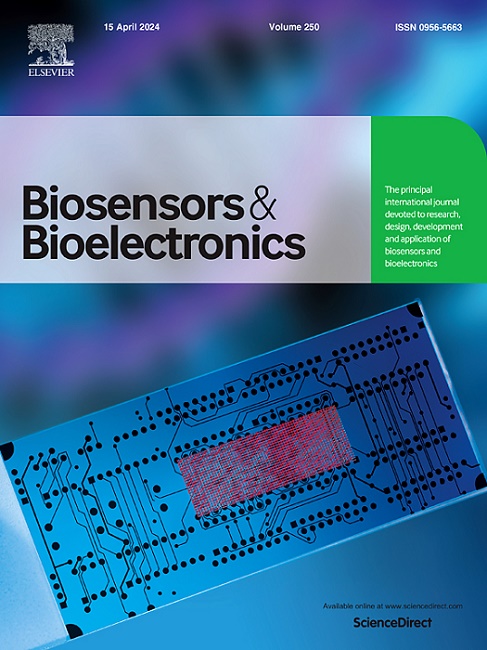通过多路复用aptamer-SERS生物传感器实现血液中阿尔茨海默病早期特征分析
IF 10.5
1区 生物学
Q1 BIOPHYSICS
引用次数: 0
摘要
神经系统疾病是导致全球死亡的第二大原因,其中阿尔茨海默病(AD)是导致全球死亡的重要原因,它造成了 2.76 亿例残疾调整生命年。传统的诊断方法往往是侵入性的,成本高昂,给全球医疗系统造成了相当大的压力。在这项研究中,我们提出了一种创新而高效的策略,即利用多孔玻璃芯片与基于适配体的表面增强拉曼散射(SERS)生物传感器集成,通过血液分析评估注意力缺失症。利用基于毛细管电泳的配体指数富集系统进化(CE-SELEX)筛选出了高亲和力的适配体。利用小鼠脑损伤模型系统研究了表明生理、血管和细胞损伤的生物标记物,如神经粒蛋白(Nrgn)、血管生成素-2(Angio-2)、PRDX3、乳酸脱氢酶(L-LDH)和τ-441,并在血液样本中对这些标记物进行了摩尔级量化。此外,在 CT 扫描成像的帮助下,还开发了一种适配体-SERS 检测方法,用于评估 AD 生物标志物的动态调节。该灵媒-SERS 生物传感器系统还被应用于人体样本,证明了其复用 AD 生物标志物的能力,并建立了生物标志物调控百分比与疾病进展之间随时间变化的相关性。该系统的创新设计、aptamer-SERS 纳米探针的制造以及生物传感的结果都表明,这种方法在临床应用中具有选择性、灵敏性和定量诊断早期注意力缺失症的巨大潜力。本文章由计算机程序翻译,如有差异,请以英文原文为准。
Early-stage Alzheimer’s disease profiling in blood achieved by multiplexing aptamer-SERS biosensors
Neurological disorders are the second leading cause of death globally, with Alzheimer’s disease (AD) emerging as a significant contributor, responsible for 276 million cases in disability-adjusted life years. Conventional diagnostic methods are often invasive, costly, and place a considerable strain on global healthcare systems. In this study, we presented an innovative and efficient strategy for AD assessment through blood profiling using a multiwell glass chip integrated with aptamer-based surface-enhanced Raman scattering (SERS) biosensors. High-affinity aptamers were selected using capillary electrophoresis-based systematic evolution of ligands by exponential enrichment (CE-SELEX). A mouse brain injury model was employed to systematically investigate biomarkers indicative of physiological, vascular, and cellular damage, such as neurogranin (Nrgn), angiopoietin-2 (Angio-2), PRDX3, lactate dehydrogenase (L-LDH), and τ-441, which were quantified at atto-molar levels in blood samples. Additionally, with the aid of CT-scan imaging, an aptamer-SERS assay was developed to evaluate the dynamic regulation of AD biomarkers. The aptamer-SERS biosensor system was also applied to human samples, demonstrating its capability to multiplex AD biomarkers and establish a time-dependent correlation between percentage biomarker regulation and disease progression. The innovative design, fabrication of aptamer-SERS nanoprobes, and the bio-sensing outcomes illustrate the strong potential of this approach for selective, sensitive, and quantitative early-stage AD diagnosis in clinical applications.
求助全文
通过发布文献求助,成功后即可免费获取论文全文。
去求助
来源期刊

Biosensors and Bioelectronics
工程技术-电化学
CiteScore
20.80
自引率
7.10%
发文量
1006
审稿时长
29 days
期刊介绍:
Biosensors & Bioelectronics, along with its open access companion journal Biosensors & Bioelectronics: X, is the leading international publication in the field of biosensors and bioelectronics. It covers research, design, development, and application of biosensors, which are analytical devices incorporating biological materials with physicochemical transducers. These devices, including sensors, DNA chips, electronic noses, and lab-on-a-chip, produce digital signals proportional to specific analytes. Examples include immunosensors and enzyme-based biosensors, applied in various fields such as medicine, environmental monitoring, and food industry. The journal also focuses on molecular and supramolecular structures for enhancing device performance.
 求助内容:
求助内容: 应助结果提醒方式:
应助结果提醒方式:


